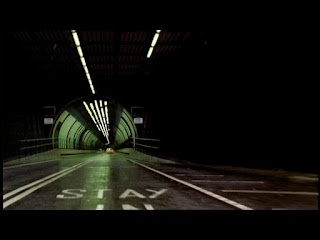What do directors
seek to establish in the openings of thrillers?
By Amber Mackenzie
The opening of a film
is always there with the intention of establishing main factors regarding
what’s to come, foreshadowing in a way. This is done through establishment of
character, tone/ mood, location and many others.
“The Disappearance Of
Alice Creed” is a great example of how character and mood/ tone are set and
established. The character is greatly displayed through this single shot.
The symmetry between
the two actors and their actions displays the organisation and methodical
elements incorporated within the scene. It also gives the audience a sense that
the characters have a lot of control. The element of teamwork also occurs here
providing the sense they’ve known each other a long time giving synchronicity.
In addition, the character on the rights curtain closes first which may hint
towards a power balance displaying him as the more dominant of the duo. The
fact this is used in addition to the technique using no dialogue and only
non-diegetic music builds a cynical tone providing this dark atmosphere
creating mystery as to what they’re doing. Furthermore, the characters are
closing curtains which is literally removing the light from the shot. This may
metaphorically foreshadow the non-literal dark themes that occur later on such
as the kidnapping of Alice Creed. The characters are shown darker as they’re up
against the light, this gives the audience the sense these characters are most
likely evil and not to be trusted further setting this dark tone through mise
en scene.
Character is also
effectively set and established within this shot from the thriller “Se7en”. The
line of items lets the audience know that the character is most likely a
perfectionist due to the order displayed within the shot. However, this may
seem so ordered as perhaps it’s the only element of his life he’s able to
organise and this could in fact be the only way of which he can establish
control and dominance that he may feel he requires. The items seem particularly
violent which suggests maybe his job is also. It also draws attention to the
odd item, the paper flower. The delicacy of this item in contrasts conveys
there’s another side to this character, most likely more emotional and gentle.
Furthermore, the dark background of the table within the shot may represent a
metaphorically dark past for the character.
Essex boys is one of
the most effective thrillers in terms of establishing the location early on,
which is convenient due to its name. This shot has a mysterious vanishing point
which makes the audience question where it leads as well as developing the
element of mystery within a single shot. Furthermore, it leads to light yet the
light seems to be trapped within the tunnel, light may display hope and
positivity so this shot suggests such things are rather limited within this
location. Moving along, there are many lights at the top of the tunnel yet many
appear broken which emphasises the urban aspect of the location. By contrast
the symmetry of the light we imagine before they broke suggests the city once
had order and control yet it’s now, clearly, been lost. The shot is wide and
narrow which almost traps the car within the shot forcing it to go through the
tunnel further emphasising this lack of control in regards to location.
Furthermore, this shot is also effective in regards to established location.
The vertical bars
across the screen give a sense of entrapment almost as prison bars would. This
represents how the character is trapped within the scene by trapping him within
the shot. In addition, the bars split him into sections which may represent his
inner conflict and lack of clarity in regards to what he’s doing or even where
he’s going. The bars also






